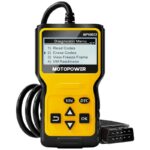Connecting your car to the internet opens up a world of possibilities, from navigation and streaming to hands-free calling and diagnostics. But what if you want Wi-Fi access without relying on your phone’s data or a separate hotspot device? That’s where bypassing the traditional OBD2 hotspot system comes in. This article explores various ways to achieve internet connectivity in your car, including how to leverage the often-overlooked OBD2 port.
While newer cars often come equipped with built-in Wi-Fi hotspots, many drivers with older models are left searching for alternative solutions. Let’s dive into the different methods for getting your car online, focusing on how the OBD2 port can be a surprising ally in your quest for connectivity.
Leveraging Your Car’s OBD2 Port for Wi-Fi
The OBD2 port, primarily used for diagnostics, can also be a gateway to internet access. While not all OBD2 devices offer Wi-Fi capabilities, some specialized devices can transform this port into a source of connectivity. These devices typically work by utilizing a cellular data connection and broadcasting a Wi-Fi signal within your vehicle.
This method offers a discreet and convenient way to bypass the need for a separate mobile hotspot device. However, it’s crucial to choose a reputable OBD2 Wi-Fi device to ensure compatibility and security. Furthermore, understand that using this method will likely require a data plan from a cellular provider.
Alternative Methods for Car Wi-Fi
Beyond the OBD2 port, there are several other ways to bring internet connectivity to your vehicle:
Smartphone Hotspot
The most common method is turning your smartphone into a mobile hotspot. This shares your phone’s data connection with other devices via Wi-Fi. While simple, this approach can drain your phone’s battery and consume significant data.
Dedicated Mobile Hotspot
Dedicated mobile hotspot devices offer a standalone solution for car Wi-Fi. These pocket-sized gadgets use a cellular data connection to create a Wi-Fi network. While requiring a separate data plan, they avoid draining your phone’s battery. They come in two main types: dongles that plug into a USB port and self-contained units with built-in batteries.
Installed Wireless Router
For the most robust connectivity, a dedicated in-car wireless router offers the strongest signal and supports multiple devices. However, this option is typically the most expensive and may require professional installation. It’s a viable solution for those who prioritize a strong and reliable connection.
Choosing the Right Solution
The best method for bypassing the traditional OBD2 hotspot system and getting Wi-Fi in your car depends on your individual needs and budget. Consider factors such as data usage, cost, installation complexity, and the number of devices you need to connect.
For a simple and cost-effective solution, a smartphone hotspot might suffice. However, for a more reliable and dedicated connection, an OBD2 Wi-Fi device or a dedicated mobile hotspot offer compelling alternatives. If budget is less of a concern and a robust connection is paramount, a professionally installed in-car router could be the ideal solution.
In conclusion, accessing Wi-Fi in your car doesn’t have to be complicated. By understanding the options available, including utilizing the OBD2 port with specialized devices, you can choose the method that best suits your needs and enjoy the convenience of internet connectivity on the road.

